SanDisk Ultra Plus SSD Review (256GB)
by Anand Lal Shimpi on January 7, 2013 9:00 AM ESTAnandTech Storage Bench 2011 - Light Workload
Our new light workload actually has more write operations than read operations. The split is as follows: 372,630 reads and 459,709 writes. The relatively close read/write ratio does better mimic a typical light workload (although even lighter workloads would be far more read centric).
The I/O breakdown is similar to the heavy workload at small IOs, however you'll notice that there are far fewer large IO transfers:
| AnandTech Storage Bench 2011 - Light Workload IO Breakdown | ||||
| IO Size | % of Total | |||
| 4KB | 27% | |||
| 16KB | 8% | |||
| 32KB | 6% | |||
| 64KB | 5% | |||
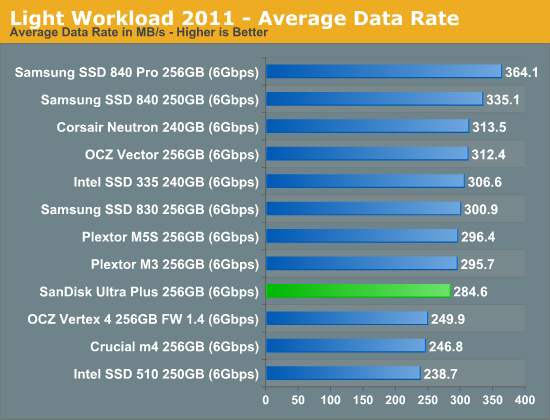
Performance doesn't change too much with our lighter workload. The Ultra Plus ends up towards the lower end of the middle of the pack.
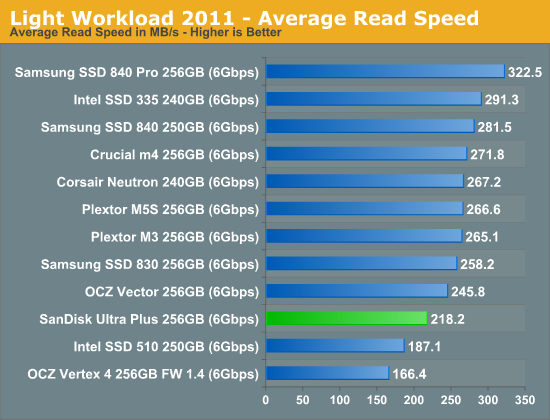
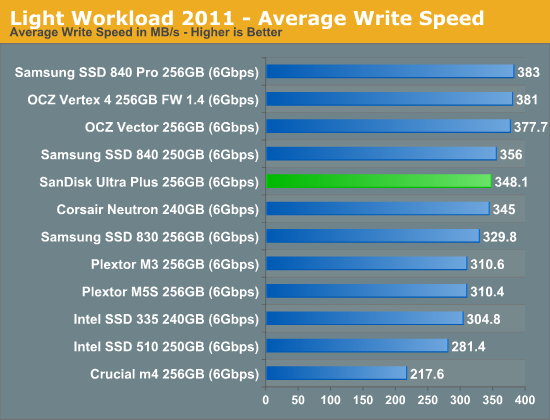
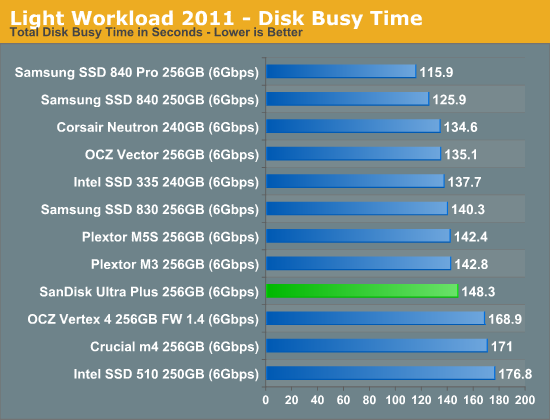

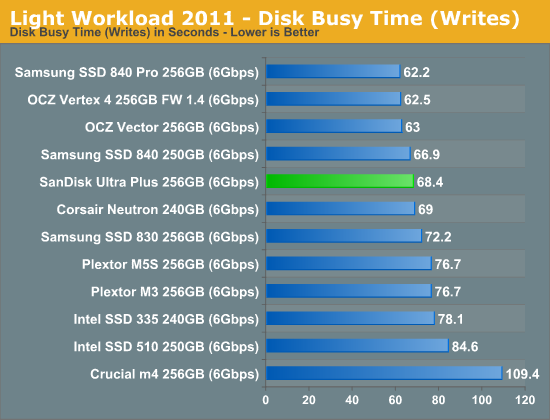










38 Comments
View All Comments
Samus - Monday, January 7, 2013 - link
I'm just dying for a mainstream Intel S3700 to hit the consumer corner...Beenthere - Monday, January 7, 2013 - link
Few if anyone would be able to differentiate a noticeable actual system performance change no matter which one of the listed SSDs they chose. SanDisk hasn't yet learned how to dupe the benches but in due time their numbers will increase similar to the others.If you're going to buy an SSD you should do your homework so you know the liabilities and realities including reliability and campatibility issues, lost data, drive size change, etc. If you want an eye opener read the warranties on SSDs at the respective SSD mfg. websites.
mrdude - Monday, January 7, 2013 - link
"The drive PCB itself is very small, potentially paving the way for some interesting, smaller-than-2.5" form factors."That's the most interesting bit, I find. Those things are absolutely tiny. So tiny that it kind of makes you wonder if standardizing the NGFF cards is even worth it going forward. If you need small storage then you can just stick with the standard SATA connectors on an itsy bitsy drive.
Very cool :)
vol7ron - Monday, January 7, 2013 - link
n-TB sizes that much more of a coming realitySmCaudata - Monday, January 7, 2013 - link
I picked up a SanDisk extreme 240 last year for about 50¢ per GB and I'm happy. Even during black Friday I didn't see anything cheaper and this drive is fast. The difference between most ssd now is academic. User experience is nearly the same for average consumers.mayankleoboy1 - Monday, January 7, 2013 - link
Isnt it the same that OCZ implemented in Vertex4 f/w 1.4 ?blowfish - Monday, January 7, 2013 - link
So for XP users, would a drive that doesn't support Trim be the way to go, since MS decided not to add Trim to XP in order to push Win7?randinspace - Monday, January 7, 2013 - link
Upgrading to Windows 7 (and pretending like 8 didn't happen even though it has enviable features...) is the way to go. Seriously speaking (upgrade), it's not like a drive that has TRIM support is going to be a bad thing even if you can't use it, but see the above comments about Sandforce controllers in general/Intel's 335 series SSDs in particular. Or even see the comments about hacking in TRIM support, IF YOU DARE!FWIW I'm very happy with the performance of my (240GB) 335. I'd probably buy another one to put in my laptop if they weren't going for $40 more than what I paid last month...
dave_the_nerd - Monday, January 7, 2013 - link
They all support TRIM. None REQUIRE it.If your OS doesn't support TRIM commands, you just have to find the drive with the best built-in GC routines. That used to be Sandforce, but I don't know anymore.
kmmatney - Monday, January 7, 2013 - link
With Samsung and Intel SSDs you can just run their toolbox software to do a manual TRIM. Iknow you can schedule it automatically with the Intel SSD Toolbox, and I think you can do that with the Samsung software as well. I've had a 40GB Intel SSD running on Windows XP for 2+ years and the TRIM scheduler works great.